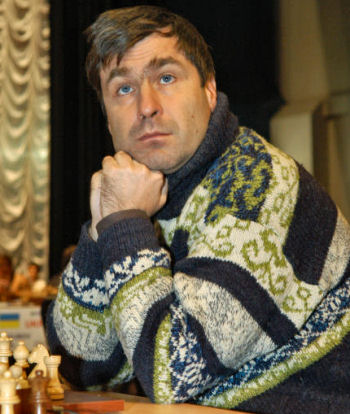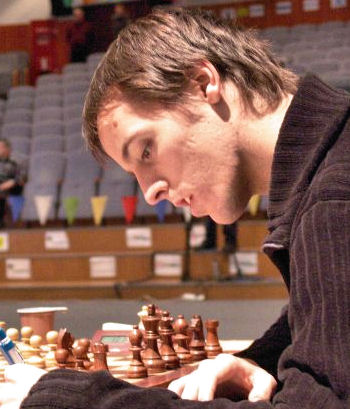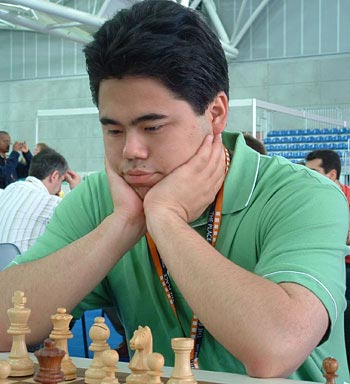| Latest | Greatest | Lobby | Journals | Search | Options | Help | Login |
|
|
|
This topic is archived. |
| Home » Discuss » Topic Forums » Sports |
|
| Jack Rabbit
|
Sun Dec-03-06 01:43 AM Original message |
| The Jack Rabbit Chess Report for December 3: Let the games begin |
|
Edited on Sun Dec-03-06 02:22 AM by Jack Rabbit
The Jack Rabbit Chess Report for the week ending December 3  Contents Post 1: News for the week Post 2: Diagrams and other features Post 3: Games from Current and Recent Events Post 4: Bonus Game: Magnus Carlsen - Erwin L'Ami, Wijk ann Zee, 2006 |
| Printer Friendly | Permalink | | Top |
| Jack Rabbit
|
Sun Dec-03-06 01:46 AM Response to Original message |
| 1. News for the week ending December 3 |
|
Edited on Sun Dec-03-06 02:41 AM by Jack Rabbit
Ivanchuk wins Capablanca Memorial
 Ukrainian grandmaster Vassily Ivanchuk won the 41st annual Torneo Memorial Capablanca, which was completed Thursday evening in Havana. Ivanchuk, who also won the event last year, won 4 games, lost 1 and drew 5 for a total of 6� points in ten games. Ivanchuk started the tournament fast by winning three of his first four games to take a two-point lead even before the half-way point in the event. He was able to coast the rest of the way with a 50% socre in his remaing games. "Chukie" had at least a share of first prize sewed up before going into the final round. Evgeny Bereev of Russia finished second with 6 points. Bareev, who is admired among grandmasters and chess enthusiasts for his wit and humor, started slowly in contrast to Ivanchuk by losing two of his first four games and failing to win a game in the entire first half of the tournament. At the half-way point, Bareev was at the foot of the table with only a point and a half. However, Bareev staged a remarkable comeback in the second half with 4� points out of five game, with only draw against Ivanchuk beween and a perfect second-half score. Unofficial Cross Table Torneo Memorial Capablanca Havana ----------------------1---2---3---4---5---6--T--(W) (-SB) 1 Vassily Ivanchuk . --- 1 � 0 � � � 1 1 1 � 6� (4) . . . 3 Evgeny Bareev. . . 0 � --- � 1 � 1 0 1 � 1 6. (4) . . . 2 Kamil Miton. . . . 1 � � 0 --- � � � � � � 5. (1) . . . 4 Lenier Dom�nguez . � � � 0 � � --- � � � � 4� (0) . . . 5 Jes�s Nogueiras. . 0 0 1 0 � � � � --- � � 4. (1) (19�) 6 Lazaro Bruz�n. . . 0 � � 0 � � � � � � --- 4. (0) (19�) The Jack Rabbit Unofficial Cross Table uses games won as first tie break It was a disappointing event for the three Cuban grandmasters competing: Lenier Dom�nguez, Lazaro Bruz�n and Jes�s Nogueiras. Nogueiras' first-round win over Bareev was the only Cuban victory in the tournament, while together the three lost six games. Along with the elite double-round robin event, the tournament also featured a ten-round a Swiss system competition among fifty players. That was won by Cuban grandmaster Walter Arenciba and Cuban international master Fidel Corrales with 7� points each. The event is named for Cuba's greatest chess player and one of the half-dozen greatest players of the twentieth century from anywhere, the former world champion Jos� Capablanca. Vallejo victorious in Spanish National Championship  Grandmaster Paco Vallejo was crowned the Spanish National Champion Thursday after winning a knockout event in Le�n. Vallejo's opponent in the last round was grandmaster Salvador Del Rio. The two played two games in as many days, with the first game ending in a draw and Vallejo. playing White, winning the second to finish the tournament. The event began with 12 players in two groups of six each playing a preliminary event with the top two players in each group advanting to the knock out stage. In the semi-final games, Vallejo defeated international master Manuel Perez by winning the first game as Black and drawing the second. Russian National Championships begin   The final leg of the Russian National Championships, known as the "Superfinal", are underway. The general event begins today in Moscow while the ladies' championship bagan Friday afternoon in Gorodets, a medieval Russian town near Novogrod strongly associated with the thirteenth-century warrior-prince, Alexander Nevsky. Both events consist of 12 players in a single round robin. The Moscow competition will see Sergey Rublevsky attempt to defend his title against Peter Svidler, Alexander Morozevich, Dmitry Jakovenko, Evgeny Najer, Evgeny Alekseev, Ernesto Iarkiev, Nikita Vitiugov, Evgeny Tomashevsky, Denis Khismatullin, Sergey Grioriants and 16-year-old Ian Neponniachtchi. Several of these players are making a first appearance in the Superfinal. Current ladies' champion Alexandra Kostiniuk, one of the world's most popular players, is unable to defend her title in Gorodets due to illness. Vying for her title are Nadezhda Kosintseva and her sister, Tatiana Kosintseva, two-time women's world title challenger Alisa Galliamova, Ekaterina Korbut, Ekaterina Kovalesvskaya, Elena Tairova, Svetlana Matveeva, Tatiana Shadrina, Elena Zaiatz, Vakentina Gunina, Marya Konaagina and 14-year-old Anastasia Bodnaruk. After two round in the ladies' event, Ekaterina Korbut leads with a perfect score with four women tied for second with 1� point each. Ukrainian National Championships underway  The 75th Ukrainian National Championships began last week. The General event, held in Poltava, is organized as a knockout tournament and will conclude today with Yuri Drozdovsky and Zahar Efimenko playing one final game for the title. The two men drew the fist game of the final round yesterday. The ladies' tournament is a single-round robin staged in Odessa. It began last Sunday. The competitors are Natalia Zhukova, Inna Gaponenko, Anna Ushenina, Tatiana Vasilevich, Diana Arutyunova, Oksana Vozovic, Natalia Zdebskaya, Katerina Dolzhikova, Marya Muzychuk, Svetlana Ivanova, Olga Kalinina and Galina Breslavska. After seven rounds, Anna Ushenina and Oksana Vozovic are fied for first with 5 points each with Natalia Zhukova, Natalia Zbebdkaya and Marya Muzychuk are a half-point behind. Chess debuts as an Olympic sport at the Asian Games  Chess makes its debut as an Olympic sport this week at the 15th Asian Games in Doha, Qatar. The first IOC-sanctioned chess game was played yesterday with the start of the men's and women's rapid tournament. The victories in the first round went such players as Petala Harikrishna of India, Rustam Kasimdzhanov of Uzbekistan and Chinese grandmaster Bu Siangshi among the men; and Indian grandmanst Koneru Humpy, Zhu Chen of Qatar and Zhao Xue of China for the women. The rapid tournament continues today and will finish tomorrow. Three rounds are played on each day in the rapid event. On Wednesday, a nine-round Swiss system team tournament begins among 22 national squads. The team tournament will be played under normal time controls at the rate of one round a day through December 14. One of the downsides of making chess an olympic sport is that chess players will now be subjected to drug testing. This has drawn hackles in the chess world, since there is no known drug that would enhance one's short-term ability to play chess. The most quotable quote on the subject came from the very quatable English grandmaster and world championship contender Nigel Short. "Doping in chess?" said Short. "Rubbish!" Deep Fritz leads Kramnik after 4 rounds  The competer program Deep Fritz 10, which is manufactured by and is commercially available through ChessBase.com, leads world champion Vladimir Kramnik in a six-game exhibition match, 2�-1�, after four round in Bonn, Germany. The score of the match could have easily been even at this point had Kramnik not made an incredible blunder during the second game. Black: Vladimir Kramnik !""""""""# $ + + N L% $W + + O % $ + + + O% $+ + P + % $oO +q+ +% $+ + + + % $ P + +pP% $+ V + +k% /(((((((() White: Deep Fritz 10 Position after 34. Ne6xf8 Can't see the diagram? Please click here. Here Black played 34. -- Qd3??. Kramnik got up to take a break, but Fritz shot back with the reply 35. Qh7, checkmate, before Kramnik could turn around. Kramnik slapped his forehead with his hand. The world champion, who is one of the most cautious, conservative and technically skilled players of our time, had just allowed a mate in one. Had Black instead played 34. -- Kg8, the game would have most likely ended in a draw. The incident reminded me of why I'm in Kramnik's corner in this match: he's human. All other games have ended in draws. The fifth game is scheduled for today. This will be Kramnik's last game with White in the match. |
| Printer Friendly | Permalink | | Top |
| Jack Rabbit
|
Tue Dec-05-06 07:49 PM Response to Reply #1 |
| 9. Update; O, Humanity! Kramnik falls to Fritz |
|
Edited on Tue Dec-05-06 07:52 PM by Jack Rabbit
The human race suffered a major humiliation today when Deep Fritz 10 defeated world champion Vladimir Kramnik in the sixth and final game of the Man vs. Machine match in Bonn, Germany.
Fritz won the match, 4-2. The machine won both decisive games. Kramnik lost game two when he uncharacteristically blundered into a mate in one, for which he was swiftly punished. Today's game was simply a case where Kramnik was simply outplayed. Kramnik's opponent had no reaction. The human race should be thankful that Fritz is incapable of gloating. The consensus in the chess world is that the match completed today is the last meaningful man vs. machine competition. The program Fritz 10 has proved itself to be strong than the world champion. As computer programs become stronger, the day is near when no human being, not even the world chess champion, could contemplate holding his own against a chess playing computer. The score of the game: 1.e4 c5 2.Nf3 d6 3.d4 cxd4 4.Nxd4 Nf6 5.Nc3 a6 6.Bc4 e6 7.O-O Be7 8.Bb3 Qc7 9.Re1 Nc6 10.Re3 O-O 11.Rg3 Kh8 12.Nxc6 bxc6 13.Qe2 a5 14.Bg5 Ba6 15.Qf3 Rab8 16.Re1 c5 17.Bf4 Qb7 18.Bc1 Ng8 19.Nb1 Bf6 20.c3 g6 21.Na3 Qc6 22.Rh3 Bg7 23.Qg3 a4 24.Bc2 Rb6 25.e5 dxe5 26.Rxe5 Nf6 27.Qh4 Qb7 28.Re1 h5 29.Rf3 Nh7 30.Qxa4 Qc6 31.Qxc6 Rxc6 32.Ba4 Rb6 33.b3 Kg8 34.c4 Rd8 35.Nb5 Bb7 36.Rfe3 Bh6 37.Re5 Bxc1 38.Rxc1 Rc6 39.Nc3 Rc7 40.Bb5 Nf8 41.Na4 Rdc8 42.Rd1 Kg7 43.Rd6 f6 44.Re2 e5 45.Red2 g5 46.Nb6 Rb8 47.a4 1-0 |
| Printer Friendly | Permalink | | Top |
| Jack Rabbit
|
Sun Dec-03-06 01:46 AM Response to Original message |
| 2. Diagrams and other features of the JR Chess Report |
|
!""""""""# $tMvWlVmT% $OoOoOoOo% $ + + + +% $+ + + + % $ + + + +% $+ + + + % $pPpPpPpP% $RnBqKbNr% /(((((((() White to move This position is a theoretical draw Does this picture make sense to you? If not, or if it looks like a bunch of Wingdings, please click here. Diagrams used in the Jack Rabbit Chess Report are made with Chess Merida, a true type font that is available as freeware at the above link. Also, the JR chess report makes the main variation in annotations more distinct and readable by putting it in red. A secondary variation, is in blue and other colors are used if needed. |
| Printer Friendly | Permalink | | Top |
| Jack Rabbit
|
Sun Dec-03-06 01:48 AM Response to Original message |
| 3. Games from current and recent events |
|
Edited on Sun Dec-03-06 01:58 AM by Jack Rabbit
Chess Games Analysis by JR and Fritz Vassily Ivanchuk - Jes�s Nogueiras, Torneo Memorial Capablanca, Round 7, Havana Paco Vallejo - Pablo Garc�a, Spanish National Championship, Round 4, Le�n Teddy Coleman - Hikaru Nakamura, National Chess Congress, Philadelphia Almira Skripchenko - Olaf Wegener, Bundesliga, Round 3, Hamburg |
| Printer Friendly | Permalink | | Top |
| Jack Rabbit
|
Sun Dec-03-06 01:52 AM Response to Reply #3 |
| 5. Ivanchuk - Nogueiras, Capablanca Memorial, Havana |
 Vassily Ivanchuk To view this game with a PGN viewer, please click here (London Chess Center). In the blurb about the Capablanca Memorial, select Games in PGN. This is the 20th game listed. Vassily Ivanchuk vs. Jes�s Nogueiras Torneo Memorial Capablanca, Round 7 Havana, November 2006 Queen's Gambit: Slav Defense (Geller Gambit) 1. d4 d5 2. c4 c6 3. Nf3 Nf6 4. Nc3 dxc4 5. e4
Black: Jes�s Nogueiras !""""""""# $ T W +lT% $+q+ +oO % $o+ +o+ O% $+ +mP + % $ +oP + +% $+ P + R % $ + +bP P% $R + K + % /(((((((() White: Vassily Ivanchuk Position after 20. -- Ra8b8 21. Qxa6!
Black: Jes�s Nogueiras !""""""""# $ + +l+ +% $+ + +o+ % $ + +o+m+% $+ + P + % $ + P + +% $+ P + R % $t+ + P +% $+r+ Kb+t% /(((((((() White: Vassily Ivanchuk Position after 35. -- Kf8c8 36. Rh3!
Black: Jes�s Nogueiras !""""""""# $ + +r+ +% $+ + +r+ % $ L +o+ +% $+ + Pm+ % $ + P + +% $TkP +p+ % $ + + + +% $T + + + % /(((((((() White: Vassily Ivanchuk Position after 48. -- Ra4a3+ 49. Kc4!
|
| Printer Friendly | Permalink | | Top |
| Jack Rabbit
|
Sun Dec-03-06 01:55 AM Response to Reply #3 |
| 6. Vallejo - Garc�a, Spanish National Championship, Le�n |
|
Edited on Sun Dec-03-06 02:19 AM by Jack Rabbit
 Paco Vallejo To view this game with a PGN viewer, please click here. Select Group A Games in PGN. This is game 10. Paco Vallejo vs. Pablo Garc�a Spanish National Championship, Round 4 Le�n, November 2006 West India Game: Indian Rat Defense (Old Indian Defense) 1. d4 d6 2. Nf3 Nf6 3. c4 Nbd7 4. Nc3 e5 5. e4 Be7 6. Be2 0-0 7. 0-0 c6 8. Re1 a6 9. a3
Black: Pablo Garc�a !""""""""# $t+ + + +% $+o+ T K % $ +oRv+ +% $W + M O % $o+oRp+ +% $P + + B % $ Pq+ Pp+% $+ + +bK % /(((((((() White: Paco Vallejo Position after 29. -- f6xg5 30. R4d5!
|
| Printer Friendly | Permalink | | Top |
| Jack Rabbit
|
Sun Dec-03-06 01:56 AM Response to Reply #3 |
| 7. Coleman - Nakamura, National Chess Congress, Philadelphia |
|
Edited on Sun Dec-03-06 02:21 AM by Jack Rabbit
 Hikaru Nakamura Teddy Coleman vs. Hikaru Nakamura National Chess Congress, Round 2 Philadelphia, November 2006 West Indian Game: Tal-Indian Defense (Benko Gambit) 1. d4 Nf6 2. c4 a6 3. Nc3 c5 4. d5 b5 5. e3!?
Black: Hikaru Nakamura !""""""""# $ T + Tl+% $+ +vO +o% $ + V +o+% $+ Bp+o+p% $ + + + +% $+ R + N % $p+ + +p+% $+ + R K % /(((((((() White: Teddy Coleman Position after 28. Rc1xc3 28. -- Rbc8!
|
| Printer Friendly | Permalink | | Top |
| Jack Rabbit
|
Sun Dec-03-06 01:57 AM Response to Reply #3 |
| 8. Skripchenko - Wegener, Bundesliga, Hamburg |
|
Edited on Sun Dec-03-06 02:56 AM by Jack Rabbit
 Almira Skripchenko To view this game: If you have a PGN viewer, please click here (Bundesliga website). Select the PGN file at the top of the page for Rende 3-4 19.11.2006. This is game 32 in that file. Almira Skripchenko (Werder Breman) vs. Olaf Wegener (SV M�lheim Nord) Bundesliga (2006-07 Season), Round 3/Board 8 Hamburg, November 2006 Spanish Sicilian Game: Canal Opening 1. e4 c5 2. Nf3 d6 3. Bb5+ Bd7 4. Bxd7+ Qxd7 5. 0-0 Nf6 6. e5
Black: Olaf Wegener !""""""""# $ + Tt+ L% $O +m+oW % $ + +o+ O% $+oO + + % $ + +n+pQ% $+ Pp+ +r% $pP + + P% $+ + +rK % /(((((((() White: Almira Skripchenko Position after 30. -- Qe5xg7 31. Rxf7! 1-0
|
| Printer Friendly | Permalink | | Top |
| Jack Rabbit
|
Sun Dec-03-06 01:50 AM Response to Original message |
| 4. Bonus Game: Carlsen - L'Ami, Wijk aan Zee, 2006 |
|
Edited on Sun Dec-03-06 02:23 AM by Jack Rabbit
Magnus Carlsen celebrated his 16th birthday last Thursday.
Here's looking at you, kid.  Magnus Carlsen Magnus Carlsen vs. Erwin L'Ami Corus B, Round 1 Wijk aan Zee, January 2006 Spanish Grand Royal Game: Yates Opening 1. e4 e5 2. Nf3 Nc6 3. Bb5 a6 4. Ba4 Nf6 5. 0-0 Be7 6. Re1 b5 7. Bb3 d6 8. c3 0-0 9. d4
Black: Erwin L'Ami !""""""""# $ +t+ + T% $+ +m+oL % $oW O Vo+% $+ +b+ + % $ O +p+n+% $+ + + +p% $pP Q Pk+% $+ +rR + % /(((((((() White: Magnus Carlsen Position after 28. -- Nc5d7 29. Bxf7!!
|
| Printer Friendly | Permalink | | Top |
| MaryBear
|
Wed Dec-06-06 12:42 AM Response to Original message |
| 10. I do not speak Chess, Jack. |
|
Even so, your reports seem increasingly well written, using more and more new computer language skills (charts, etc.). If you are not careful, someone will pay you to do this. How about reporting on, and photographing, the Tuesday evening games/players/coaches? Preview it here then sell to local paper.
Or to the Sacramento Bee or LA Times. B-) :toast: :beer: |
| Printer Friendly | Permalink | | Top |
| DU
AdBot (1000+ posts) |
Sun May 05th 2024, 08:36 PM Response to Original message |
| Advertisements [?] |
| Top |
| Home » Discuss » Topic Forums » Sports |
|
Powered by DCForum+ Version 1.1 Copyright 1997-2002 DCScripts.com
Software has been extensively modified by the DU administrators
Important Notices: By participating on this discussion board, visitors agree to abide by the rules outlined on our Rules page. Messages posted on the Democratic Underground Discussion Forums are the opinions of the individuals who post them, and do not necessarily represent the opinions of Democratic Underground, LLC.
Home | Discussion Forums | Journals | Store | Donate
About DU | Contact Us | Privacy Policy
Got a message for Democratic Underground? Click here to send us a message.
© 2001 - 2011 Democratic Underground, LLC